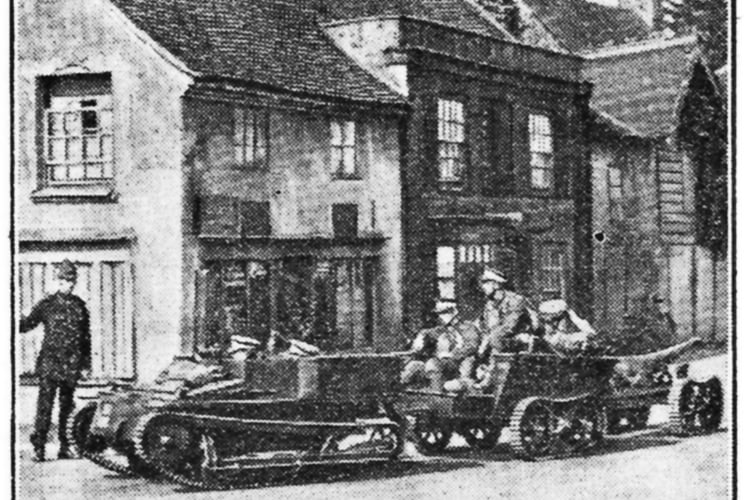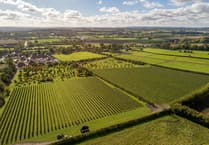SOLDIERS trundling through Chobham with their vehicles and horses was once a regular sight for villagers in years gone by, especially leading up to and during the First World War.
The picture postcard here belongs to Mark Coxhead and is captioned ‘Army Manoeuvres 1907 “a council of War” Chobham’, and shows the military was quick to adopt motor-vehicles.
The undated newspaper cutting that also features military vehicles passing through the village is courtesy of Chobham Museum. The caption says the policeman is on duty at a Chobham crossroads, but he is actually standing at the junction of Vicarage Road – now mainly known as Bagshot Road – and High Street. The shops pictured were demolished in the 1930s so that the junction could be widened.
Military manoeuvres on Chobham Common had been taking place for some time, such as the famous Great Camp in August 1853 in which two batches of 8,000 men and 1,500 horses mustered on the heathland for drill, field operations and parades, with a visit from Queen Victoria.
A further military manoeuvre took place in 1871 across the heath between Chobham and the “home of the British Army” at Aldershot. And so they continued into the 1900s, as recorded by Graham Webster, who has published on the internet his detailed research titled Man’s Influence on Chobham Common.
Graham discovered that in 1907 the War Office was looking at using the common regularly. However, its owner, Lord Onslow – the lord of the manor of Chobham – was concerned the public might flock to watch what was going on. They had flocked, in many thousands and from as far as London, to watch the Great Camp activities.

During the First World War, troops barracked at Woking, Pirbright and Aldershot used the common to practise trench warfare, and in August 1915 manoeuvres involved the whole of the 24th Division, as part of Lord Kitchener’s New Third Army.
Graham writes that soldiers were instructed in trench construction and trench attack, carried out under active service conditions. The 8th Battalion Royal (West Kent) Regiment, as part of the division was inspected by Lord Kitchener on 19 August.
Throughout the month the manoeuvres comprised two opposing forces who marched under war conditions until they met after dark. Each side dug themselves in. Work was continued under war conditions until 7am the next morning. Then peace conditions resumed to enable the completion of the trenches more quickly.
Graham noted it was intended the troops should occupy the trenches for some days and reliefs should be practised, and finally a trench-to-trench attack and consolidation carried out. However, weather was very bad, and the scheme was abandoned on the second day.
On 24 August, George V with Queen Mary and Princess Mary inspected the 24th Division and passed along the trenches “held” by the 13th Middlesex Regiment.
In 1917, with the ground being very dry, a wildfire broke out and soldiers helped to bring the blaze under control.
The military continued to use the common during the inter-war years and evidently were responsible for much damage including the digging of defensive ditches and by army vehicles.
Indeed, it was heavy military vehicles that were to be a feature of the common during the Second World War and beyond. This began in 1942 with the Fighting Vehicles Proving Establishment being opened on common land at Longcross – later dubbed the Chobham Tank Factory.
Tanks and other armoured vehicles were tested on the common, causing extensive damage to the swathes of heather that had led to it being known as Little Scotland.
With many changes and mergers over the years, the operation had several changes of name and eventually became the Military Vehicles and Engineering Establishment (MVEE) and then part of the Defence Evaluation and Research Agency (DERA).
In the early 2000s, the site was handed over to the semi-privatised Qinetiq defence technology firm, which eventually moved all the military operations out of Longcross and sold most of the land and adjoining test track to developers.
The main factory site is now home to the film and television production units of Longcross Studios and 200 homes have been built on the adjacent land, the first housing of what will become Longcross Garden Village. Another 1,500 houses are to be built on the other side of the M3 motorway.
Graham Webster’s website is www.chobhamcommon.wordpress.com.
If you have some memories or old pictures relating to the Woking area, call David Rose on 01483 838960, or drop a line to the News & Mail.
David is a local historian and writer who specialises in what he calls “the history within living memory” of people, places and events in the west Surrey area covering towns such as Woking and Guildford. He collects old photos and memorabilia relating to the area and the subject, and regularly gives illustrated local history talks to groups and societies. For enquiries and bookings please phone or email him at: [email protected]




